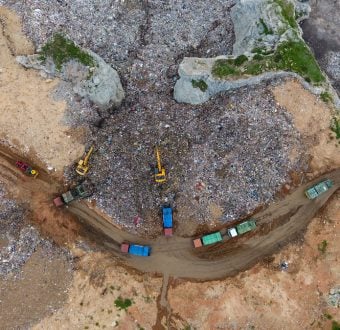Slashing protection would leave one million hectares of forest vulnerable to further deforestation and biodiversity loss according to Greenpeace. Images of the overflight, made by renowned photographer Daniel Beltrá, can be seen here.
Despite a 75% increase in deforestation between 2012 and 2015 in the Amazon, the minister of Civil Office, Eliseu Padilha, and Brazil’s president, Michel Temer, are considering a proposal to the National Congress in the coming weeks to cancel one entire Conservation Area and reduce four others by 40%. This move would end protection for around one million hectares of forest and hand the region to land-grabbers.
“If Brazil’s president, Michel Temer, takes the proposal to reduce Conservation Areas forward, he will both encourage those who destroy the forest and betray those who have worked to help Brazil preserve it. Cutting protected areas at a time when deforestation rates are increasing is the opposite of what Brazil needs to do to combat forest destruction. Now, more than ever, it is important to pressure the government to stop this proposal and keep on track to reduce deforestation,” said Cristiane Mazzetti, Greenpeace Brazil Amazon Campaigner.
The Conservation Areas that are at risk are located in an extremely strategic region that acts as a barrier preventing the advance of deforestation and illegal occupation. Amazonas state is known as the region with the largest continuous area of Amazonian forest and still has many intact forest areas. If those areas are lost, many environmental services provided by the forest to the world will be compromised. Already in 2016, deforestation in Amazonas state grew by 54% from the year before. [1]
Brazilian parliamentarians from Amazonas state argue that the Conservation Units are obstacles to rural producers’ investments in the region. Greenpeace Brazil recently conducted flyovers of the region to document possible human occupations and signs of logging, farming and other activities, as well as to capture images of the forest that is at stake if this proposal moves forward.
The overflight showed large areas of preserved forest in the area under threat, with little evidence of occupations other than some gold mining and roads. Around the border of the Conservation Units there was evidence of some recent deforestation and burned areas — possibly the signs of new farms or timber logging. [2] There are many stakeholders who would be interested in the proposed cuts to Conservation Units as a chance to expand destructive human activities into protected areas.
At a time when Brazil should be taking urgent action to reduce deforestation, it is instead creating major setbacks for environmental conservation, especially in the Amazon. By considering the parliamentarians’ proposal, the Brazilian government is seriously compromising its commitments ratified in the Paris Agreement to fight global warming. [3] It also breaks promises made with international donors, such as Norway and Germany, that supported the country in its efforts to control deforestation in the Amazon in the last several years.[4]
“The creation of Conservation Units was a successful strategy that contributed to reducing the Amazon deforestation rate between 2005 and 2012. With this proposal, the government would give the green light to land grabbers, resulting in even higher deforestation rates. If we want to keep global warming at or below 1.5 C, ending deforestation in Brazil is an important step,” said Mazzetti.
ENDS
Notes for editors:
[1] Prodes (Deforestation Monitoring Program for the Legal Amazon), operated by the National Institute for Space Research (INPE) of Brazil, conducts satellite monitoring of deforestation by clear-cutting on the Legal Amazon and has compiled the annual rates of deforestation for the region since 1988. These are used by the Brazilian government to determine public policy.
[2] Images of the overflight, made by renowned photographer Daniel Beltrá, can be seen here.
[3] The Paris Agreement includes an explicit call to developed and developing countries to reduce emissions. Currently, about 40% of Brazil’s greenhouse gas emissions come from deforestation, being the sixth country that most emits greenhouse gases in the world.
[4] The Amazon Fund was created in 2008 and received donations of one billion dollars from Norway between 2009 and 2016 – the country intends to keep the same level of investment until 2020. Germany donated 28 million dollars for the Amazon Fund between 2010-2014 and is also a donor of the Program for Protected Areas in the Amazon (ARPA). In 2015 a cooperation between Brazil and Germany resulted in an investment of 31.7 million euros to this project.
[5] On Feb, 21, civil society in Brazil submitted to the government a repudiation note to any proposal that would lead to those conservation units reduction. Read it here.
[6] A map of the potentially impacted Conservation Areas can be seen here.
Media contact:
Rodrigo Estrada, [email protected], 202-478-6632.



